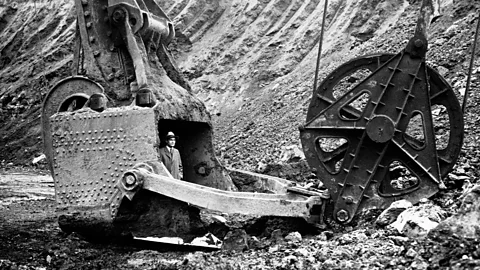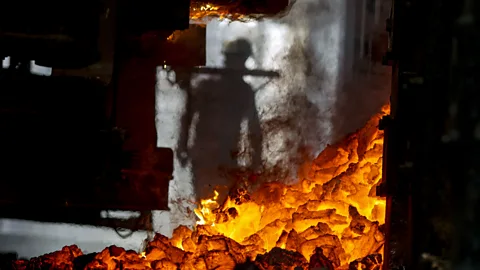A US engineer had a shocking plan to improve the climate – burn all coal on Earth
 Getty Images
Getty ImagesLess than a century ago, people believed setting alight every coal mine on the planet would be good for the climate. The fact we've come so far in our understanding since then provides hope for the future, argues historian Thomas Moynihan.
Not a week goes by without a steady stream of headlines conveying our worsening climate predicament. There are stories about lack of preparedness, about perverse incentives, about political inaction and record-breaking metrics, or about the brute complexity of the problem. Swirling together, these meld into a general sense of intractability. Given this now-familiar news diet, it's sometimes difficult to maintain optimism when it comes to society's capacity to manage the climate crisis. But as a historian, I find it helps to zoom out.
Looking to the not-too-distant past reveals that the sheer fact we are aware of the issue is a genuine achievement. Easy to otherwise overlook, history throws into relief how far we have already come in our understanding.
Less than a century ago, even the experts of the day were talking about climate change in ways that would shock our 21st-Century sensibilities. To see why, you need only look at the claims of one prominent US engineer called William Lamont Abbott, who advocated an idea now unthinkable: he wanted to burn every gram of coal on Earth – and remarkably, he believed that would be a good thing.
You may also like:
Today, everyone is familiar with the idea that the Earth's climate is a complicated system. Although it contains predictable cycles and trends, even schoolchildren are aware that it can be erratic and sensitive to civilisation's interferences. But a century or so ago, people had far more simplistic outlooks.
For much of the 1800s, physicists had been led to believe our planet was, essentially, a cooling body: inexorably losing its finite fund of heat to space's void, like a hot Christmas pudding dropped in snow. People feared encroaching cold, foreseeing life withering away on a dwindling diet of warmth.
 Getty Images
Getty ImagesChanging these views took years of research – and even then, some scientific findings were not immediately recognised as important. For instance, suffragist Eunice Foote realised as far back as the 1850s that carbon dioxide retains heat and, thus, an Earthly atmosphere with more of it would be warmer. Foote's pioneering contribution was overlooked, likely due to sexism. (Watch: "Three pioneers who predicted climate change".)
Only around 1900 did scientists begin making further connections between atmospheric CO2 and larger climate trends. This came from searching for the causes behind the Ice Ages: prehistoric pulses of planetary freezing which implied that — rather than being a heated ball monotonously losing its warmth in a nosedive decline — the Earth's climate is in a complicated equilibrium. One capable of maintaining balance over voluminous tracts of time, but also of severe oscillations.
Around this time, scientists also first made the link between humanity's burning of fossil fuels and Earth's future climate. Liberating colossal amounts of CO2, the planetary juggernaut of industrial civilisation suddenly seemed poised to rapidly warm our globe.
How did people respond to this conjecture? Having grown up fearing a frozen future, many rejoiced. And that brings us to William Lamont Abbott's case – and his erroneous beliefs about the benefits of burning all our reserves of coal.
The plan to burn the world's coal
An engineer by trade, Abbott was not uninfluential, nor some lone maverick. Chief operating engineer of Illinois's largest electric provider, he also held other prominent roles. Fittingly, a powerplant was named after him.
In the late 1920s, he travelled the US delivering lectures to various learned societies. Talking to one room in the picturesque Pennsylvanian town of Scranton in 1927, Abbott welcomed industry's accelerating use of fossil fuels. Why? Because he had hastily concluded this could only benefit the world, by making climates more clement.
For him, accelerating consumption wasn't enough. Estimating there are several trillion tonnes of carbon still locked underground globally, he reasoned that this storehouse, if "returned to the air", could increase atmospheric levels tenfold.
With staggering self-assurance, Abbott announced such a dramatic increase in CO2 would double Earth's arable surface, by transforming polar countries into temperate paradises. He envisioned perpetual summers, jungles in America's north-east, unprecedented crop yields, and unimaginably verdant environments; an outcome, he said, which was demanded by humanity's "increasing population". He even prophesied tropical animals — including elephants — would return to North America, becoming "garden pests".
 Getty Images
Getty ImagesAbbott then arrived at his action plan. Despite nonchalantly acknowledging scientists didn't yet understand all the intricacies, he arrived at his conclusion: "Let the nations of the Earth unite", he said, in immediately setting alight all their deepest coal seams, so as to release the planet's entire "treasure of carbon".
He even claimed countries ought not "regulate the fire to the varying demand of power", but simply "let it rage day and night" — luxuriantly and wastefully — in order to make the world's mines into one "roaring furnace".
All this, he insisted, should be done in the name of "posterity", accelerating humankind towards future utopia: a "return" to Eden.
Moreover, Abbott was not unique in holding these beliefs. Swedish physicist Svante Arrhenius — the period's leading expert on climate change — had also remarked, cheerfully, that global warming will only precipitate better climates and crops. Others readily assumed similar things. When they acknowledged a hotter world might unevenly make the Global South "suffer", they shrugged rather than shuddered.
Only very few scattered voices, such as geologist Thomas Chrowder Chamberlin, were more prescient. He urged his contemporaries to practise self-restraint when it came to coal appetites, seeing this as necessary to safeguard a stable climate for future generations. But, despite sensing the gravity of the challenge, he also saw reason to hope people might rise to the task. Pointing out that, when cooperating at large-scale, humankind has so far only tended to disturb or destroy ecosystems, Chamberlin also hinted that we are the first and only animal to realise its impacts. What's more, when considering human history, people have only just begun grasping this and, thus, acting toward rectifying it.
Today's consensus concerning climate change and its consequences rests, in part, on the past's egregious mistakes. Getting closer to truth unavoidably involves being wrong before. Because of this, Abbott's case suggests that one shouldn't be hasty when it comes to acting drastically in what you think is the interest of future generations.
 Getty Images
Getty ImagesBut the main lesson here is this: only by inspecting past mistakes do we see how far we've since come. This allows us to gain some sense of how much farther we might yet travel. Our knowledge of the imminent dangers of human-caused climate change rests on countless computer models alongside a vast, planet-wrapping array of sensors and satellites. An attempt to simulate Earth's changing states – like a planetary central nervous system – it is a staggering achievement. Through building up this megastructure, and through the unceasing efforts of countless researchers since Abbott's day, we've travelled leagues from the rash naiveté of even just a century ago.
This proves societies can, and do, learn. It throws into relief just how much — and how rapidly — outlooks and priorities can change and become more sophisticated and insightful as we piece together more about the world. Several generations ago, it simply hadn't yet sufficiently occurred to scientists that climate change might unleash significant harms. Now it's overwhelmingly accepted. It's likely we are missing similarly vital insights today, insights that would enable us to navigate our world far more wisely. Strangely, this is cause for optimism, as having room for improvement is far better than having none at all.
Historically speaking, we have only very recently become aware of our planetary predicament. Perhaps, then, it's still too early to dismiss Homo sapiens as inevitably, forevermore, doomed to be a blight upon its world. It's clear that we have so much more to do to avert the worst effects of climate change, but if we look how far we've come, in a relatively short time, there are reasons for cautious hope.
*Thomas Moynihan is a historian of ideas and author of X-Risk: How Humanity Discovered Its Own Extinction (MIT Press, 2020). Currently, he is a visiting researcher at Cambridge University's Centre for the Study of Existential Risk. He tweets at @nemocentric and can be found at thomasmoynihan.xyz.
--
If you liked this story, sign up for The Essential List newsletter – a handpicked selection of features, videos and can't-miss news delivered to your inbox every Friday.
